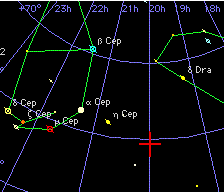The Constellations
 The random arrangement of the stars visible to the naked eye has remained essentially unchanged since the time of the first written records. One of the earliest complete lists we have was compiled in about 120 BC by the Greek astronomer Hipparchus, and all the stars that he described can be found, with the same brightness and in practically the same place, in our skies today. The whole sky has been arbitrarily divided into eighty-eight areas, which differ greatly in size and shape. Each area is a 'constellation,' or group of stars, and was thought to represent a mythical or semi-mythical being. Over half the constellations were recognized and mentioned by Hipparchus (and by Ptolemy, whose star catalogue came down to us through the Moslem scholars as the 'Almagest'). The remaining constellations lie in the Southern Hemisphere and were not named until the sixteenth and seventeenth centuries.
The random arrangement of the stars visible to the naked eye has remained essentially unchanged since the time of the first written records. One of the earliest complete lists we have was compiled in about 120 BC by the Greek astronomer Hipparchus, and all the stars that he described can be found, with the same brightness and in practically the same place, in our skies today. The whole sky has been arbitrarily divided into eighty-eight areas, which differ greatly in size and shape. Each area is a 'constellation,' or group of stars, and was thought to represent a mythical or semi-mythical being. Over half the constellations were recognized and mentioned by Hipparchus (and by Ptolemy, whose star catalogue came down to us through the Moslem scholars as the 'Almagest'). The remaining constellations lie in the Southern Hemisphere and were not named until the sixteenth and seventeenth centuries.
Few of the groups of stars that form constellations look much like the objects they represent. Much imagination is needed to see the 'pictures' seen by those gazing at the skies so many years ago. As the earth moves around the sun in its yearly cycle, the sun appears to 'move' through the constellations. The path is known as the ecliptic. The constellations along the ecliptic were given special significance, and became known as the 'signs of the zodiac'.
In antiquity the beginning of the year was reckoned from the start of spring, called the vernal equinox. The vernal equinox and the autumnal equinox are the two days each year when day and night are equal in length. The constellation through which the sun is passing at the time of vernal equinox changes slowly with the centuries, and therefore the stars associated with the season of spring also change slowly. In the time of Hipparchus the sun was in Aries at the time of vernal equinox; today it is in Pisces, but will soon move into Aquarius (hence we are now at the 'dawning of the age of Aquarius'). From tablets found in the Euphrates valley, we find they started the year when the sun was in the constellation Taurus, the 'Bull in Front'. If the sun was in Taurus at vernal equinox when the constellation was named, the date would have been about 2450 BC!
About the Author
NASA Marshall Space Flight Center
 The George C. Marshall Space Flight Center, located in Huntsville, Alabama, is the U.S. government's civilian rocketry and spacecraft propulsion research center. As the largest NASA center, MSFC's first mission was developing the Saturn launch vehicles for the Apollo program.
The George C. Marshall Space Flight Center, located in Huntsville, Alabama, is the U.S. government's civilian rocketry and spacecraft propulsion research center. As the largest NASA center, MSFC's first mission was developing the Saturn launch vehicles for the Apollo program.


